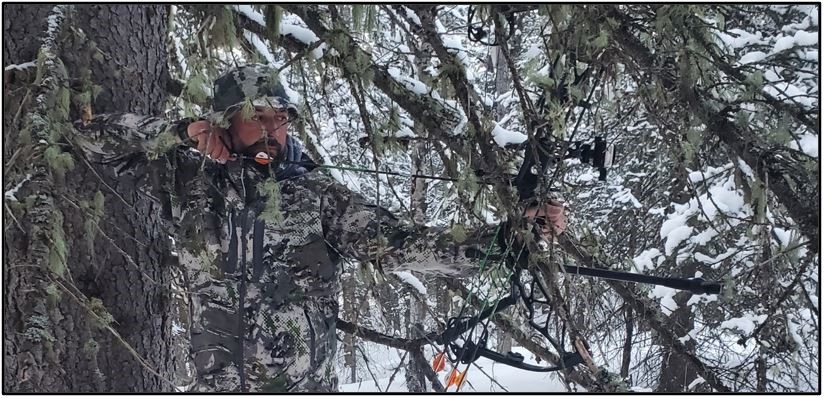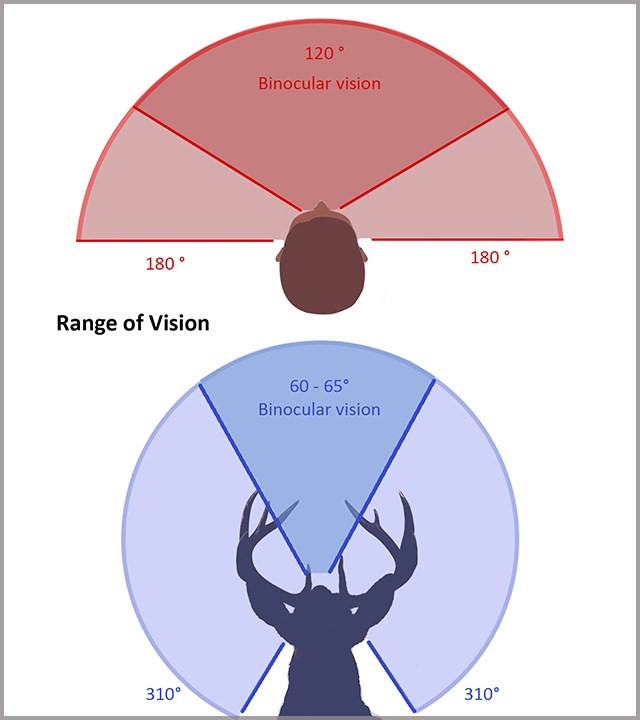Korth Group Outdoor Education, Understanding Camouflage

When hunting, we must carefully consider various factors that help conceal our presence from animals. The scent we give off, the sounds we make, and the physical outline of our person all play crucial roles in remaining undetected in nature. In North America, we are fortunate to hunt a diverse range of species, from elk and deer to bears, sheep, and goats. Each species has its own strengths and weaknesses in their detection tactics, but in this edition of Korth Group Outdoor Education, we will focus on the quality of eyesight that the deer family, or Cervidae, possess and explore effective camouflage techniques that hunters can use to maximize their stealth and become more successful in the field.

HOW WELL CAN DEER SEE?
Deer and other members of the Cervidae family have excellent hearing but their vision is not as sharp, with eyesight similar to needing glasses if they were human. Their large eyes are positioned in a way that limits their ability to focus on objects vertically, although they can focus well horizontally due to a wide visual streak on their retina. Deer see short wavelengths, like blue, better than humans, but struggle with longer wavelengths like red and orange. Unlike humans, deer lack UV filters in their eyes, making blue colours more prominent to them. They have a wide field of vision, seeing 310 degrees around with a stationary head and 360 degrees with a slight head turn. Despite having poor daytime vision at 20/100, deer excel at night due to high-density rods, horizontally slit pupils, and a reflective layer in their eyes called the tapetum lucidum, which enhances their night vision, allowing them to see 50 times better than humans in the dark. The fact that deer have a hard time picking up colours like red and orange, it provides us hunters with the advantage of being able to wear blaze orange clothing while hunting, for safety reasons, but still remaining concealed to the vision of deer and animals alike.

THE SCIENCE BEHIND CAMOUFLAGE
Why do we wear camouflage? Well, the simple answer is to blend seamlessly into the environment, preventing game from detecting your presence. Depending on the environment that you are hunting in, specific camouflage may be better suited for that area than others. Camouflage patterns vary in effectiveness based on the environment and time of year, making it crucial to choose the right one for your hunting conditions. For example, a woodland camo pattern, with its mix of greens, browns, and dark shades, is ideal for dense forests during spring and summer when foliage is abundant. In contrast, during fall, when leaves have turned and the landscape is more barren, a pattern with more earth tones, like browns and grays, can help you blend in better. Similarly, if you’re hunting in snowy conditions, a pattern with white and gray tones will offer better concealment than a standard woodland camo.
The style of hunting that you do can also dictate what camouflage would be best. For example, if you are hidden inside a dimly lit ground blind, dark solid colours may be a better option than camo patterns that include limbs and leaves. This is the opposite if you are hunting in a tree stand and need to blend into the foliage canopy. The right pattern allows you to stay hidden and avoid detection, increasing your chances of success.
HOW DO DEER SEE CAMOUFLAGE?
Due to the limited visual acuity of Cervidae during daylight hours, deer have difficulty detecting camouflage patterns. These patterns effectively break up the hunter’s physical outline, allowing them to blend seamlessly into their surroundings. While deer are highly sensitive to movement, their ability to discern fine details is poor, making it hard for them to differentiate between a camouflaged hunter and the environment. As long as the hunter remains still, the camouflage will do the work of keeping them concealed.
TYPES OF CAMOUFLAGE PATTERNS
MIMICRY PATTERNS
Mimicry camouflage patterns are designed to replicate specific elements of the environment, such as leaves, branches, or bark, making the wearer appear as part of the natural surroundings. These patterns are particularly effective in areas where hunters are likely to be stationary, such as in tree stands or ground blinds, where blending in with the immediate surroundings is crucial. Mimicry camo works best in dense forests, woodlands, or areas with heavy vegetation, especially during seasons when foliage is abundant. By closely resembling the textures and colors of the environment, mimicry camouflage helps hunters remain undetected by prey that relies heavily on sight to detect threats. Popular mimicry camo includes patterns like Realtree and Mossy Oak.

BREAKUP PATTERNS
Breakup camouflage patterns are designed to disrupt the human outline by using a mix of large, irregular shapes and contrasting colors, making it difficult for game animals to recognize a hunter as a distinct figure. Unlike mimicry patterns that imitate specific elements of the environment, breakup camo focuses on creating visual confusion, effectively blending the hunter into various backgrounds. This type of camouflage is particularly useful in diverse terrains, such as open fields, rocky landscapes, or mixed woodland areas, where the surroundings vary and a single pattern might not match precisely. Breakup camo is especially effective when hunters are on the move or hunting in areas with sparse cover, as it prevents animals from easily identifying and locking onto the hunter’s shape. Popular breakup camo includes patterns like Kryptek, KUIU, Badlands, First Lite and Sitka.

Understanding the visual capabilities of Cervidae and selecting the appropriate camouflage are critical components of successful hunting. By leveraging the weaknesses in a deer’s vision and choosing camouflage patterns tailored to the environment and season, hunters can effectively blend into their surroundings and remain undetected. Whether you opt for mimicry patterns that replicate natural elements or breakup camo that distorts your outline, the key is to stay still and let your camouflage work to your advantage. With the right preparation and knowledge, you can enhance your stealth and increase your chances of a successful hunt.
